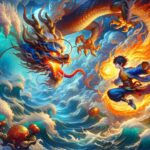Dragon Slayer East vs. West: Nezha vs. Ao Bing and Western Myths Explored
Dragons have been powerful symbols in both Eastern and Western mythologies, but their meanings and the heroes who slay them differ dramatically. This article contrasts Nezha’s legendary battle with the dragon prince Ao Bing in Chinese mythology against Western dragon-slaying tales like St. George and Beowulf. By examining these myths, we uncover what dragons represent in each culture and how their defeats reflect deeper values.
The Nature of Dragons: Divine vs. Monstrous
In Chinese mythology, dragons like Ao Bing are often divine beings tied to water, weather, and imperial authority. When Nezha defeats Ao Bing, it is not a simple triumph of good over evil but a complex clash of duty and destiny. Ao Bing, though antagonistic, is a dragon prince—a being of noble status—and his death reshapes Nezha’s karmic path. The battle reflects themes of cosmic balance and moral consequence rather than pure heroism.
In contrast, Western dragons—such as those slain by St. George or Beowulf—are almost always malevolent forces that threaten civilization. They hoard treasure, demand sacrifices, and embody chaos. St. George’s victory represents the Christian triumph over paganism, while Beowulf’s fight against the dragon underscores the warrior’s inevitable mortality. Western dragon-slaying myths emphasize human dominance over primal nature and the divine right to conquer evil.
The Heroes’ Journeys: Enlightenment vs. Conquest
Nezha’s battle with Ao Bing is part of a broader spiritual transformation. A rebellious yet righteous figure, Nezha ultimately submits to heavenly order, showing that redemption and harmony are possible even after violent conflict. His victory is not just physical—it is metaphysical, reinforcing Confucian and Taoist ideals of balance.
Western dragon slayers, however, are celebrated for their martial prowess and divine favor. St. George is a saintly knight whose deed earns him veneration, while Beowulf dies a legendary king, his fight a final act of valor. Their victories are linear: evil is vanquished, and order is restored through strength. Unlike Nezha’s introspective journey, Western myths highlight external triumph and the establishment of a just hierarchy.
Conclusion: Divergent Symbols in Shared Myths
Dragons and their slayers reveal much about cultural priorities. Eastern myths, like Nezha’s, treat dragons as part of a divine order—defeating them is a moral reckoning, not just conquest. Western myths frame dragons as existential threats, their slayers as saviors who uphold civilization. Whether invoking enlightenment or dominance, these stories show how deeply myth reflects a society’s values, fears, and aspirations.

